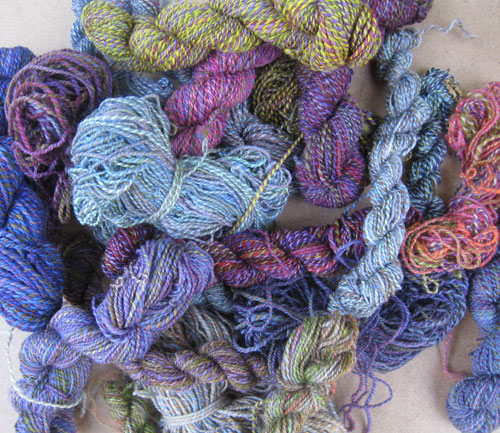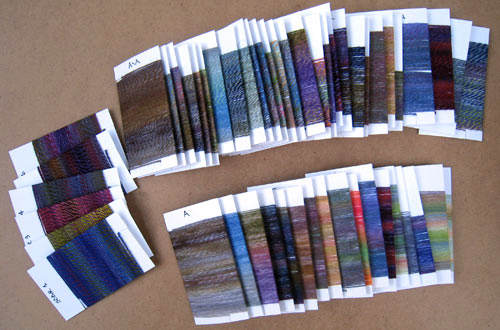I’ve been looking at the pile of little tiny skeins of plied yarn from my two workshops with Deb Menz (SOAR 2008 and Spring 2009). They are a pretty lot.

I wrapped them onto old business cards*…

Then I took the leftover bits and started a project…

Pretty, isn’t it? Too bad it’s on hold right now. The rippling edges are bugging me. It took me a while to figure out why they ripple. And to explain, we have to go back to high school geometry.
The strips are knitted on the diagonal with 15 stitches. Since that edge is basically the hypotenuse of an isosceles right triangle, from geometry, we know that the width of the strip is 15 / sqrt(2), or approximately 10.6 stitches wide.
But when I do short rows to turn the corner**, I have a block that is 15 stitches wide. 15 is definitely wider than 10.6. And this forces the triangle created by the short rows to bulge out. The bulge disappears when you work the next strip outward because the elastic garter stitch allows the diagonal strips to be pulled out.
So, why am I abandoning it? While the inside strips will be straight, the edges will always be wonky. Since I don’t intend to block the blanket, the wavy outer edge will always remain. Will that be a bad thing? Will it be noticeable when I’m curled up on the couch? Or can I just call it structural interest? The answer to the 2nd question is no. I don’t know the answer to the other 2 questions yet. I also don’t know if it will bug me forever or if I will get over it. Until I figure it out, it’s going to stay at this stage. Or until I come up with another design.
So, Attempt 1 is on hold. Yes, Attempt 1.
Attempt 2 has already been ripped. It was based on Vivian Hoxbro’s domino theory. But I couldn’t come up with a satisfactory layout that satisfied one of my primary goals for this project: No snipping of already short skeins. Keep using the skein until it runs out and splice/darn in a new mini-skein. The project needs to be continuous. Domino knitting can be done with a continuous yarn, but I wasn’t happy with how the diagonals of the blocks are lining up. (After the first few blocks, I went to paper and pencil and diagrammed out to a 5×5 block and it sucked royally.) So, it has been ripped.
 This brings us to Attempt 3. Just a normal garter strip of 12 sts wide. Since the piece is knit straight, the short row corners will maintain the lines of the fabric, thus, no bulges. As with Attempt 1, I will work this in a spiral from the center out. This will satisfy my other goal: a design that allows me to keep going and stop (almost) anytime I want. No pre-planning required, except to save enough yarn for an i-cord edging. But the good news there is, I can always spin more.
This brings us to Attempt 3. Just a normal garter strip of 12 sts wide. Since the piece is knit straight, the short row corners will maintain the lines of the fabric, thus, no bulges. As with Attempt 1, I will work this in a spiral from the center out. This will satisfy my other goal: a design that allows me to keep going and stop (almost) anytime I want. No pre-planning required, except to save enough yarn for an i-cord edging. But the good news there is, I can always spin more.
Why didn’t I go with a log cabin blanket? While the center of these blankets start with a small/narrow strip of knitting, the subsequent rounds create wider and wider strips of knitting. With my tiny sample skeins, some of them may not even span a single row before I have to start a new skein. This will dilute the colors too much. This brings me to another goal: highlight the individuality of these skeins by concentrating them into small blocks of color.
When this last sample is the same size as Attempt 1, I’ll do a side by side comparison before deciding on which design to continue with. Or to come up with Attempt 4.
(You know, I’m beginning to know what Charlene goes through when she is designing by the seat of her pants. Or skirt. Or something.)
In the meantime, I’m practicing my knitting and purling backwards. By the end of this, I should be quite ready to work on my Kathryn Alexander kit.
* Why business cards? Because I have a lot of old business cards. These business cards are of good quality cardboard and of a great size for wrapping yarn samples. I used to trim my own from art boards, but that got old, and they aren’t always the same size. At my last couple of jobs, each time I moved offices, I had to order new cards. And we played musical offices every 6 months or so. They finally got wise and started to use standard mailing address on the cards. But then I changed job titles…Anyway, the bottom line is that I have a large supply of these things.
Why save wrapped samples? I have a couple of reasons for doing this. One is record keeping. I wanted to be able to reference back to what A looks like as a single and what happens when A is paired with something of a different hue, value, and saturation.
The second reason for these wrapped cards is for play. When I took my color workshops with Michele Whipplinger, I loved playing with her hundreds of yarn/thread wrapped cards. We spent hours just rummaging through these cards and pairing them together in different combinations. The idea of building hundreds of these cards at a go is a daunting one. This is why I still don’t have any. But I’m changing that, starting now.
Yes, Michele’s cards were mostly solid colors, but no matter. It’s still fun to play with these. Each time I look at a plied sample, I get a different impression, depending on my mood. What I didn’t think was working in the sample yesterday isn’t the same as my thoughts today. It’s still a good color exercise. Having the singles to refer back to allows me to figure out what I need to do to replicate, or change a single aspect of the plied yarn.
** Turning the corner for working on the diagonal is really the reverse of a normal short-row corner. You start out knitting 2 sts, turn, and start nibbling back, working 1 more stitch with each subsequent row. Once you reach the full width, you have essentially put a square edge to the diagonal piece. Now, you have to get the new side back on the diagonal by working wrapped short rows.
Ed. Note: Fixed a few typos (knibbling indeed!) and light balanced the yarn cards.

Grace
You can control the ripply edges with a small border of GS.
Your yarn samples would also make a wonderful ouroborus. See the pix in Unexpected Knitting, a highly inspirational book.